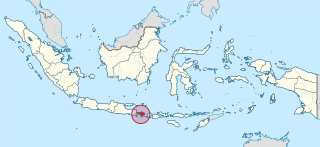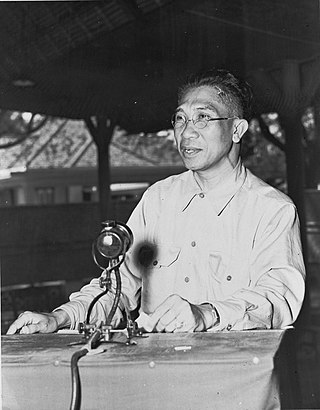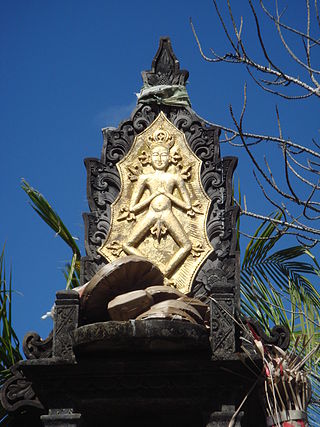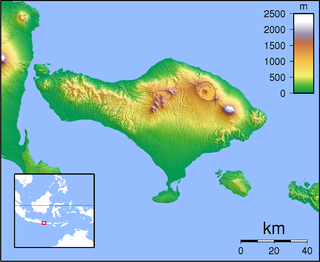
Bali is a province of Indonesia and the westernmost of the Lesser Sunda Islands. East of Java and west of Lombok, the province includes the island of Bali and a few smaller offshore islands, notably Nusa Penida, Nusa Lembongan, and Nusa Ceningan to the southeast. The provincial capital, Denpasar, is the most populous city in the Lesser Sunda Islands and the second-largest, after Makassar, in Eastern Indonesia. Denpasar metropolitan area is the extended metropolitan area around Denpasar. The upland town of Ubud in Greater Denpasar is considered Bali's cultural centre. The province is Indonesia's main tourist destination, with a significant rise in tourism since the 1980s, and becoming an Indonesian area of overtourism. Tourism-related business makes up 80% of the Bali economy.
Shudra or Shoodra is one of the four varnas of the Hindu class and social system in ancient India. Some sources translate it into English as a caste, or as a social class. Theoretically, Shudras constituted a class like workers.

Balinese Hinduism, also known in Indonesia as Agama Hindu Dharma, Agama Tirtha, Agama Air Suci or Agama Hindu Bali, is the form of Hinduism practised by the majority of the population of Bali. This is particularly associated with the Balinese people residing on the island, and represents a distinct form of Hindu worship incorporating local animism, ancestor worship or Pitru Paksha, and reverence for Buddhist saints or Bodhisattava.

The Balinese people are an Austronesian ethnic group native to the Indonesian island of Bali. The Balinese population of 4.2 million live mostly on the island of Bali, making up 89% of the island's population. There are also significant populations on the island of Lombok and in the easternmost regions of Java.

Ubud is a town on the Indonesian island of Bali in Ubud District, located amongst rice paddies and steep ravines in the central foothills of the Gianyar regency. Promoted as an arts and culture centre, it has developed a large tourism industry. It forms a northern part of the Greater Denpasar metropolitan area.

Hinduism is the third-largest religion in Indonesia, based on civil registration data in 2023 from Ministry of Home Affairs, is practised by about 1.68% of the total population, and almost 87% of the population in Bali. Hinduism was the dominant religion in the country before the arrival of Islam and is one of the six official religions of Indonesia today. Hinduism came to Indonesia in the 1st-century through Indian traders, sailors, scholars and priests. A syncretic fusion of pre-existing Javanese folk religion, culture and Hindu ideas, that from the 6th-century also synthesized Buddhist ideas as well, evolved as the Indonesian version of Hinduism. These ideas continued to develop during the Srivijaya and Majapahit empires. About 1400 CE, these kingdoms were introduced to Islam from coast-based Muslim traders, and thereafter Hinduism, which was previously the dominant religion in the region, mostly vanished from many of the islands of Indonesia.

Besakih Temple is a pura in the village of Besakih on the slopes of Mount Agung in eastern Bali, Indonesia. It is the most important, largest, and holiest temple of Balinese Hinduism, and one of a series of Balinese temples. Perched nearly 1000 meters up the side of Gunung Agung, it is an extensive complex of 23 separate but related temples with the largest and most important being Pura Penataran Agung. The temple is built on six levels, terraced up the slope. The entrance is marked by a candi bentar, and beyond it, the Kori Agung is the gateway to the second courtyard.

Newar caste system is the system by which Newārs, the historical inhabitants of Kathmandu Valley, are divided into groups on the basis of Vedic varna model and divided according to their hereditary occupations. First introduced at the time of the Licchavis, the Newar caste system assumed its present shape during the medieval Malla period. The Newar caste structure resembles more closely to North India and Madheshis than that of the Khas 'Parbatiyas' in that all four Varna and untouchables are represented. The social structure of Newars is unique as it is the last remaining example of a pre-Islamic North Indic civilisation in which Buddhist elements enjoy equal status with the Brahmanic elements.
A Balinese name is part of a system of identification used by the Balinese people and in the western parts of the neighboring island of Lombok, Indonesia. A Balinese name will have three parts: a title, a birth order name and a personal name. Balinese people do not use a family name.

Dewa Agung or Deva Agung was the title of the kings of Klungkung, the foremost in rank among the nine kingdoms of Bali, Indonesia. It was also borne by other high-ranking members of the dynasty. The term Dewa means "god" and was also a general title for members of the Ksatria caste. Agung translates as "high" or "great". Literally, the title therefore means Great God.

Tjokorda Gdé Raka Soekawati was a Balinese nobleman and politician who served as the first and only president of the State of East Indonesia from 1946 until its dissolution in 1950. His title, Tjokorda Gdé, signaled that Soekawati belonged to the highest ksatria. He had two wives, the first a Balinese, Gusti Agung Niang Putu, who gave him a son named Tjokorda Ngurah Wim Sukawati. In 1933, he married a French woman named Gilbert Vincent, who gave him two children.

Achintya, also known as Sang Hyang Widhi Wasa and Sang Hyang Tunggal, is the Supreme God of Indonesian Hinduism, especially on the island of Bali. Achintya is equivalent to the metaphysical concept of Brahman of Indian Hinduism and is the Supreme God in traditional wayang theatre. All gods, goddesses, and existence are believed to be the manifestation of the Achintya in Balinese Hinduism.

The History of Bali covers a period from the Paleolithic to the present, and is characterized by migrations of people and cultures from other parts of Asia. In the 16th century, the history of Bali started to be marked by Western influence with the arrival of Europeans, to become, after a long and difficult colonial period under the Dutch, an example of the preservation of traditional cultures and a key tourist destination.

Babad Dalem is a historical account from Bali, Indonesia, which exists in a large number of versions of varying length. The title may be translated as "Chronicle of Kings", although the Balinese babad genre does not quite accord to Western-style chronicles. There are dated manuscripts from the early 19th century onwards, and the original version was very likely written in the course of the 18th century. The author was probably a Brahmin tied to the Klungkung Palace, the most prestigious of the nine pre-colonial royal seats of Bali.

Dalem Di Made was a king of Bali who may have reigned in the period 1623–1642. He belonged to a dynasty that claimed descent from the Majapahit Empire of Java, and kept residence in Gelgel, close to Bali's south coast.

Javanese Kshatriya were a Hindu Kshatriya community which originally existed in the island of Java in Indonesia. According to the ancient Hindu law, the Kshatriyas have the exclusive right to bear arms in order to defend the country. Indigenous Kshatriya communities currently exist in India, Nepal, Bangladesh, Pakistan, Sri Lanka, Vietnam as well as in the island of Bali in Indonesia.
Balinese Kshatriya is a Hindu Kshatriya community that exists on the island of Bali in Indonesia. During the second half of the sixth century, Bali had a strong Kshatriya ruling dynasty. The rulers were mostly indigenous Balinese with some Indian blood. These clans mostly belonged to the Nāgavanshi dynasty. However, in due time, these indigenous Kshatriyas became extinct and were replaced by the Javanese Kshatriyas who immigrated to Bali. Most of the Kshatriyas now living in Bali are claimed to be the descendants of King Dewa Agung, who immigrated to Bali from Java. However, there are also a few other Kshatriya clans who were elevated to the Kshatriya status from the Vaishya varna. Altogether, Kshatriyas constitute around 4% of the total Balinese Hindu population.

A Pura is a Balinese Hindu temple and the place of worship for adherents of Balinese Hinduism in Indonesia. Puras are built following rules, style, guidance, and rituals found in Balinese architecture. Most puras are found on the island of Bali, where Hinduism is the predominant religion; however many puras exist in other parts of Indonesia where significant numbers of Balinese people reside. Mother Temple of Besakih is the most important, largest, and holiest temple in Bali. Many Puras have been built in Bali, leading it to be titled "the Island of a Thousand Puras".

The Kingdomship of Bali was a series of Hindu-Buddhist kingdoms that once ruled some parts of the volcanic island of Bali, in Lesser Sunda Islands, Indonesia. With a history of native Balinese kingship spanning from the early 10th to early 20th centuries, Balinese kingdoms demonstrated sophisticated Balinese court culture where native elements of spirit and ancestral reverence combined with Hindu influences—adopted from India through ancient Java intermediary—flourished, enriched and shaped Balinese culture.














